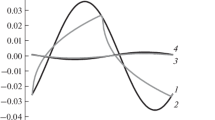Abstract
It is demonstrated that the thermocapillarity effect can either raise or lower the threshold of surface wave excitation, depending on the conditions of heating.
Similar content being viewed by others
Literature cited
L. D. Landau and E. M. Lifshits, Mechanics of Continuous Media [in Russian], GITTL, Moscow-Leningrad (1944).
G. Z. Gershuni and E. M. Zhukovitskii, Convective Stability of Incompressible Fluids, Halsted Press (1976).
R. V. Birikh, “Thermocapillary convection in horizontal layer of fluid,” Zh. Prikl. Mekh. Tekh. Fiz., No. 3, 69–72 (1966).
A. N. Filatov, Method of Averaging for Differential and Integrodifferential Equations [in Russian], FAN, Tashkent (1971).
V. V. Moskvitin, Resistance of Viscoelastic Materials [in Russian], Nauka, Moscow (1972).
Author information
Authors and Affiliations
Additional information
Translated from Inzhenerno-Fizicheskii Zhurnal, Vol. 46, No. 3, pp. 424–428, March, 1984.
Rights and permissions
About this article
Cite this article
Nevolin, V.G. Effect of thermocapillarity on parametric excitation of surface waves. Journal of Engineering Physics 46, 303–306 (1984). https://doi.org/10.1007/BF00831372
Received:
Issue Date:
DOI: https://doi.org/10.1007/BF00831372




